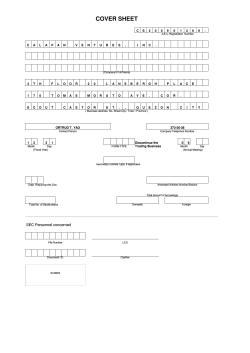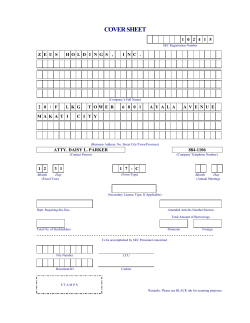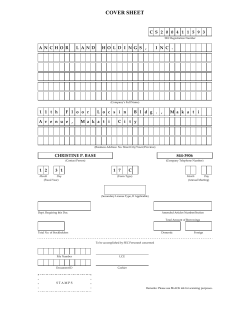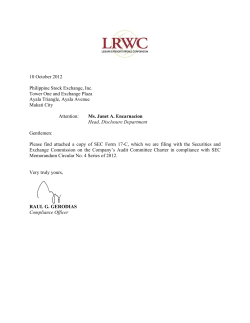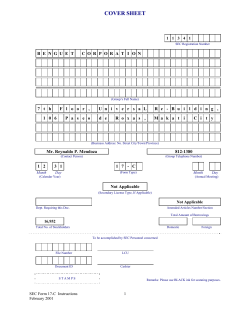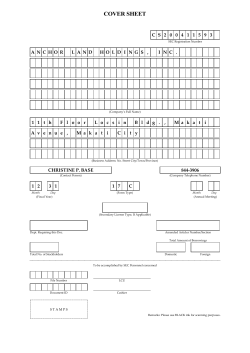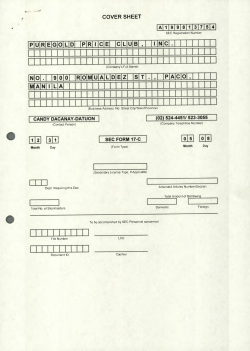
SOLUTIONS MANUAL TO ACCOMPANY INTRODUCTION TO FLIGHT 7
SOLUTIONS MANUAL TO ACCOMPANY INTRODUCTION TO FLIGHT 7th Edition By John D. Anderson, Jr. Chapter 2 2.1 ρ = p/RT = (1.2)(1.01× 105 )/(287)(300) ρ = 1.41 kg/m 2 v = 1/ρ = 1/1.41 = 0.71 m3 /kg 2.2 3 3 k T = (1.38 × 10−23 ) (500) = 1.035 × 10−20 J 2 2 One kg-mole, which has a mass of 4 kg, has 6.02 × 1026 atoms. Hence 1 kg has 1 (6.02 × 1026 ) = 1.505 × 1026 atoms. 4 Mean kinetic energy of each atom = Totalinternal energy = (energy per atom)(number of atoms) = (1.035 ´10-20 )(1.505 ´1026 ) = 1.558 ´ 106 J 2.3 ρ= 2116 slug p = = 0.00237 3 ft RT (1716)(460 + 59) Volume of the room = (20)(15)(8) = 2400 ft 3 Total mass in the room = (2400)(0.00237) = 5.688slug Weight = (5.688)(32.2) = 183lb 2.4 ρ= p 2116 slug = = 0.00274 3 RT (1716)(460 - 10) ft Since the volume of the room is the same, we can simply compare densities between the two problems. Δρ = 0.00274 - 0.00237 = 0.00037 % change = 2.5 Δρ ρ = slug ft 3 0.00037 ´ (100) = 15.6% increase 0.00237 First, calculate the density from the known mass and volume, ρ = 1500 / 900 = 1.67 lb m /ft 3 In consistent units, ρ = 1.67/32.2 = 0.052 slug/ft 3. Also, T = 70 F = 70 + 460 = 530 R. Hence, p = ρ RT = (0.52)(1716)(530) p = 47, 290 lb/ft 2 or p = 47, 290 / 2116 = 22.3 atm 2 PROPRIETARY MATERIAL. © 2012 The McGraw-Hill Companies, Inc. All rights reserved. No part of this Manual may be displayed, reproduced, or distributed in any form or by any means, without the prior written permission of the publisher, or used beyond the limited distribution to teachers and educators permitted by McGraw-Hill for their individual course preparation. A student using this manual is using it without permission. 2.6 p = ρ RT np = np + nR + nT Differentiating with respect to time, 1 dp 1 d ρ 1 dT = + p dt ρ dt T dt or, dp p d ρ p dT = + dt ρ dt T dt or, dp dρ dT = RT + ρR dt dt dt (1) At the instant there is 1000 lbm of air in the tank, the density is ρ = 1000 / 900 = 1.11lb m /ft 3 ρ = 1.11/32.2 = 0.0345slug/ft 3 Also, in consistent units, is given that T = 50 + 460 = 510 R and that dT = 1F/min = 1R/min = 0.016 R/sec dt From the given pumping rate, and the fact that the volume of the tank is 900 ft3, we also have d ρ 0.5 lb m /sec = = 0.000556 lb m /(ft 3 )(sec) dt 900 ft 3 d ρ 0.000556 = = 1.73 × 10−5 slug/(ft 3 )(sec) dt 32.2 Thus, from equation (1) above, dρ = (1716)(510)(1.73 × 10−5 ) + (0.0345)(1716)(0.0167) dt 16.1 = 15.1 + 0.99 = 16.1 lb/(ft 2 )(sec) = 2116 = 0.0076 atm/sec 2.7 In consistent units, T = −10 + 273 = 263 K Thus, ρ = p/RT = (1.7 × 104 )/(287)(263) ρ = 0.225 kg/m3 2.8 ρ = p/RT = 0.5 ×105 /(287)(240) = 0.726 kg/m3 v = 1/ρ = 1/0.726 = 1.38 m3 /kg 3 PROPRIETARY MATERIAL. © 2012 The McGraw-Hill Companies, Inc. All rights reserved. No part of this Manual may be displayed, reproduced, or distributed in any form or by any means, without the prior written permission of the publisher, or used beyond the limited distribution to teachers and educators permitted by McGraw-Hill for their individual course preparation. A student using this manual is using it without permission. 2.9 Fp = Force due to pressure = ò 3 p dx = 0 3 ò (2116 - 10 x) dx 0 = [2116 x - 5 x 2 ] 30 = 6303 lb perpendicular to wall. Fτ = Force due to shear stress = ò 3 τ dx = 0 ò 3 0 90 (x + 1 9) 2 dx 1 = [180 ( x + 9) 2 ] 30= 623.5 - 540 = 83.5 lb tangential to wall. Magnitude of the resultant aerodynamic force = R = (6303) 2 + (835) 2 = 6303.6 lb æ 83.5 ÷ö = 0.76º çè 6303 ÷÷ø θ = Arc Tan çç 3 V∞ sin θ 2 Minimum velocity occurs when sin θ = 0, i.e., when θ = 0° and 180°. 2.10 V = Vmin = 0 at θ = 0° and 180°, i.e., at its most forward and rearward points. Maximum velocity occurs when sin θ = 1, i.e., when θ = 90°. Hence, Vmax = 3 (85)(1) = 127.5 mph at θ = 90°, 2 i.e., the entire rim of the sphere in a plane perpendicular to the freestream direction. 4 PROPRIETARY MATERIAL. © 2012 The McGraw-Hill Companies, Inc. All rights reserved. No part of this Manual may be displayed, reproduced, or distributed in any form or by any means, without the prior written permission of the publisher, or used beyond the limited distribution to teachers and educators permitted by McGraw-Hill for their individual course preparation. A student using this manual is using it without permission. 2.11 The mass of air displaced is M = (2.2)(0.002377) = 5.23 ´ 10-3 slug The weight of this air is Wair = (5.23 ´10-3 )(32.2) = 0.168 lb This is the lifting force on the balloon due to the outside air. However, the helium inside the balloon has weight, acting in the downward direction. The weight of the helium is less than that of air by the ratio of the molecular weights WH c = (0.168) 4 = 0.0233 lb. 28.8 Hence, the maximum weight that can be lifted by the balloon is 0.168 − 0.0233 = 0.145 lb. 2.12 Let p3, ρ3, and T3 denote the conditions at the beginning of combustion, and p4, ρ4, and T4 denote conditions at the end of combustion. Since the volume is constant, and the mass of the gas is constant, then p4 = ρ3 = 11.3 kg/m3. Thus, from the equation of state, p4 = ρ4 RT4 = (11.3)(287)(4000) = 1.3 ´ 107 N/m 2 or, p4 = 1.3 ´ 107 1.01 ´ 105 = 129 atm 2.13 The area of the piston face, where the diameter is 9 cm = 0.09 m, is A= (a) π (0.09) 2 4 = 6.36 ´ 10-3 m 2 The pressure of the gas mixture at the beginning of combustion is p3 = ρ3 RT3 = 11.3(287)(625) = 2.02 ´ 106 N/m 2 The force on the piston is F3 = p3 A = (2.02 ´ 106 )(6.36 ´10-3 ) = 1.28 ´ 104 N Since 4.45 N = l lbf, F3 = (b) 1.28 ´ 104 = 2876 lb 4.45 p4 = ρ4 RT4 = (11.3)(287)(4000) = 1.3 ´ 107 N/m 2 The force on the piston is F4 = p4 A = (1/3 ´107 ) (6.36 ´10-3 ) = 8.27 ´ 104 N F4 = 8.27 ´ 104 = 18,579 lb 4.45 5 PROPRIETARY MATERIAL. © 2012 The McGraw-Hill Companies, Inc. All rights reserved. No part of this Manual may be displayed, reproduced, or distributed in any form or by any means, without the prior written permission of the publisher, or used beyond the limited distribution to teachers and educators permitted by McGraw-Hill for their individual course preparation. A student using this manual is using it without permission. 2.14 Let p3 and T3 denote conditions at the inlet to the combustor, and T4 denote the temperature at the exit. Note: p3 = p4 = 4 ´ 106 N/m 2 (a) ρ3 = p3 4 ´ 106 = 15.49 kg/m3 = RT3 (287)(900) (b) ρ4 = p4 4 ´ 106 = 9.29 kg/m3 = RT4 (287)(1500) 2.15 1 mile = 5280 ft, and 1 hour = 3600 sec. So: æ miles ÷öæ 5280 ft ÷öæ 1 hour ÷ö çç 60 ÷çç ÷çç ÷ = 88 ft/sec. èç hour ÷øèç mile ÷øèç 3600 sec ÷ø A very useful conversion to remember is that 60 mph = 88 ft/sec also, 1 ft = 0.3048 m æ ö æ ÷öç 0.3048 m ÷÷ = 26.82 m ç 88 ft ÷ç ÷÷ ÷èç 1 ft çèç sec ø÷ç sec ø Thus 2.16 88 ft m = 26.82 sec sec 692 miles 88 ft/sec = 1015 ft/sec hour 60 mph 692 miles 26.82 m/sec = 309.3 m/sec hour 60 mph 2.17 On the front face Ff = p f A = (1.0715 ×105 )(2) = 2.143 ×105 N On the back face Fb = pb A = (1.01 × 105 )(2) = 2.02 × 105 N The net force on the plate is F = Ff − Fb = (2.143 − 2.02) ×105 = 0.123 × 105 N From Appendix C, 1 lb f = 4.448 N. So, F= 0.123 ×105 = 2765 lb 4.448 This force acts in the same direction as the flow (i.e., it is aerodynamic drag.) 6 PROPRIETARY MATERIAL. © 2012 The McGraw-Hill Companies, Inc. All rights reserved. No part of this Manual may be displayed, reproduced, or distributed in any form or by any means, without the prior written permission of the publisher, or used beyond the limited distribution to teachers and educators permitted by McGraw-Hill for their individual course preparation. A student using this manual is using it without permission. 2.18 Wing loading = W 10,100 = = 43.35 lb/ft 2 233 s In SI units: W lb 4.448 N 1 ft = 43.35 2 s ft 1 lb 0.3048 m 2 W N = 2075.5 s m2 In terms of kilogram force, kg f N 1kf W = 2075.5 2 = 211.8 2 m 9.8 N m s miles 5280 ft 0.3048 m 5 m = 703.3 km 2.19 V = 437 = 7.033 × 10 hr mile 1 ft hr hr 0.3048 m = 7620 m = 7.62 km Altitude = (25, 000 ft) 1 ft ft 0.3048 m 3 m = 7.925 km 2.20 V = 26, 000 = 7.925 × 10 sec 1 ft sec sec 2.21 From Fig. 2.16, length of fuselage = 33 ft, 4.125 inches = 33.34 ft 0.3048 m = 33.34 ft = 10.16 m ft wing span = 40 ft, 11.726 inches = 40.98 ft 0.3048 m = 40.98 ft = 12.49 m ft 7 PROPRIETARY MATERIAL. © 2012 The McGraw-Hill Companies, Inc. All rights reserved. No part of this Manual may be displayed, reproduced, or distributed in any form or by any means, without the prior written permission of the publisher, or used beyond the limited distribution to teachers and educators permitted by McGraw-Hill for their individual course preparation. A student using this manual is using it without permission.
© Copyright 2025

